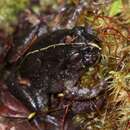Brief Summary
provided by IABIN
Diagnosis A medium-sized frog (males 42.9-50 mm, females 41-64 mm) which is characterized by having a distinctive olive-green band between the eyes, which is absent in E. roseus, E. calcaratus, E. vittatus, E. migueli and E. insularis. Furthermore it differs from E. vittatus in snout-vent length. The mating call of E. emiliopugini has two notes while that of E. vittatus possesses five (4-6) notes.
- author
- Esteban O. Lavilla
- editor
- Diego Arrieta
Distribution
provided by IABIN
Known in Chile from northeastern Osorno Province (Termas de Puyehue) to Aisén Province (Caleta Vidal, Kent, and Rivero Islands), and Lago Puelo National Park in the Province of Chubut, Argentina.
- author
- Esteban O. Lavilla
- editor
- Diego Arrieta
Diagnostic Description
provided by IABIN
Adult morphology Head wider than long. Snout pointed in dorsal view, slightly sloping in lateral profile; canthus rostralis indistinct and rounded; loreal region slightly concave; nostrils dorso-lateral, closer to tip of snout than to the orbit; length of the eye greater than distance between eye and nostril; inter-orbital distance narrower than length of eye, greater than internarial distance. Tympanic membranae medium and well defined, tympanum diameter three fourths the distance between eye and nostril. Well developed supratympanic fold extending posteriorly from the corner of the eye to the posterior part of the tympanum, covering upper part of tympanic annulus but not reaching insertion of arm. Tongue large, ovoid, with notch at the tip. Choanae small, round dentigerous process of vomers lying slightly below choanae; each process bearing 3-4 slightly oblique teeth close to median line. Forelimbs thin. First finger equal in length to second; third finger much longer than fourth; digital length in decreasing order III-IV-II-I. Palmar webbing absent; tips of fingers rounded and slightly prominent. Inner median palmar tubercle ovoid; outer palmar tubercle horseshoe-shaped; subarticular tubercles globular and moderate in size; supernumerary palmar tubercles present. Hind limbs slender. Toes long, slender, and moderately fringed; tips of toes rounded; third and fifth toes equal in length; toes in decreasing order of length IV-(III,V)-II-I. Inner metatarsal tubercle ovoid and prominent, outer rudimentary. Subarticular tubercles ovoid; supernumerary tubercles absent. Tarsal fold absent. Rudiment of web among toes. Anal opening oriented transversely and directed postero-ventrally at dorsal level of thighs. Dorsal and ventral skin smooth. Two weakly developed paravertebral folds extending from posterior part of head, converging behind it. Post-tympanic areas and flanks with scarce minute granules. Some specimens with slight granular area around vent and posterior part of thighs. Coloration in preservative: Dorsal ground color light gray with few whitish minute spots; a delicate vertebral line extending from the tip of snout to the vent. A dark greenish band on the eyes. Venter whitish and gular area gray. Lips gray with two or three irregular spots reaching the tympanic region. Arms light gray and crossed by two or three irregular transverse bars of dark gray color in dorsal area; arms and legs whitish ventrally. Coloration in life: Dorsal ground color grayish brown to leaden; vertebral line lemon-yellow. Band on eyes olive-green colored. Some specimens with bright yellowish reticulations on the thighs. Belly whitish and the gular area of mature males bright orange. Larval morphology Larvae in stage 37 (Gosner, 1960) with body ovoid in lateral view, two times longer than deep; contour of the snout flattish. Nostrils small, situated between eye and snout tip. Eyes lateral, diameter 1.7 times the interocular distance. Mouth small and anteromedial, labial papillae interrupted anteriorly, few denticles and tooth formula 2/2; beak well developed. Anal tube medial; no spiracle but small ventrolateral fissure on the left side of the body. Caudal musculature robust, dorsal and ventral fins well developed; end of tail rounded. Color in life: creamy-white abdomen and fins transparent; internal organs visible. Minute melanophores among the nearest muscular septa to the body. Dorsal areas of head and trunk scarcely pigmented.
- author
- Esteban O. Lavilla
- editor
- Diego Arrieta
Behavior
provided by IABIN
América do norte (Oregon)

